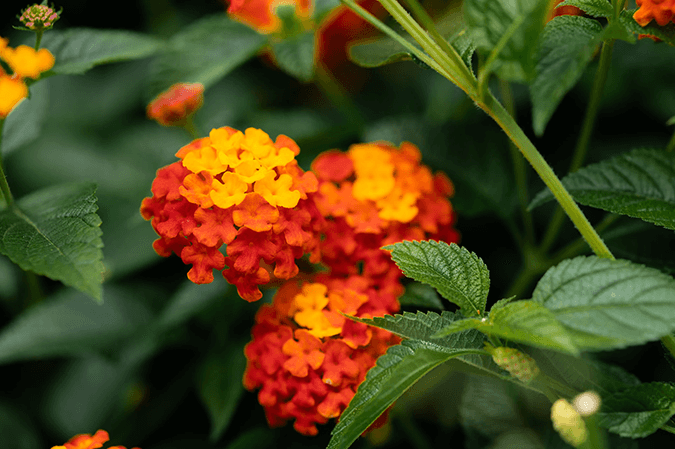Lantanas are a genus of flowering plants belonging to the family Verbenaceae. Known for their vibrant and colorful flowers, Lantanas are widely cultivated for ornamental purposes in gardens and landscapes. Despite their beauty, Lantanas are considered invasive in many parts of the world due to their aggressive growth and ability to outcompete native plants.
Description
- Appearance: Lantanas are typically small, perennial shrubs that can grow up to 1-2 meters in height. They have a bushy, sprawling growth habit, and their stems are often woody at the base with softer, green branches.
- Leaves: The leaves of Lantanas are simple, opposite, and typically rough or hairy to the touch. They are oval-shaped with serrated edges and emit a strong, pungent aroma when crushed.
- Flowers: Lantana flowers are small and tubular, clustered together in dense, rounded inflorescences. The flowers are usually multi-colored, with shades of red, orange, yellow, pink, purple, and white often appearing together in a single cluster. As the flowers mature, they often change color, which adds to the plant’s visual appeal.
- Fruit: The fruit of the Lantana is a small, berry-like drupe that changes from green to dark purple or black as it ripens. These fruits are toxic to humans and some animals if ingested.
Common Features
- Drought Tolerance: Lantanas are highly drought-tolerant and can thrive in poor, dry soils. This makes them ideal for xeriscaping and low-maintenance gardens.
- Heat and Sun Tolerance: They prefer full sun and are highly resistant to heat, making them popular in tropical and subtropical regions.
- Invasive Potential: Lantanas are notorious for their invasive nature, particularly in regions like Australia, Africa, and the Americas. They can quickly spread and dominate landscapes, outcompeting native vegetation and disrupting local ecosystems.
Role in the Ecosystem
- Pollinator Support: Lantanas are excellent at attracting pollinators, particularly butterflies and bees. Their brightly colored flowers are a rich source of nectar, supporting the lifecycle of many pollinating insects.
- Habitat for Wildlife: The dense foliage of Lantanas provides shelter for various small animals and insects. Birds are also attracted to Lantanas for their berries, although the fruits are toxic to some species.
- Invasive Impact: In areas where Lantanas are invasive, they can have a detrimental effect on local ecosystems. By outcompeting native plants, they reduce biodiversity and alter habitats, which can negatively impact local wildlife.
Importance
- Ornamental Value: Lantanas are widely used in gardens, parks, and urban landscaping for their vibrant and long-lasting flowers. They are often grown in borders, containers, and hanging baskets.
- Erosion Control: Due to their dense, sprawling growth habit and ability to thrive in poor soils, Lantanas are sometimes used for erosion control on slopes and in degraded landscapes.
- Medicinal Uses: In traditional medicine, parts of the Lantana plant have been used to treat ailments such as respiratory infections, skin diseases, and gastrointestinal issues. However, caution is necessary due to the plant’s toxicity.
- Cultural Significance: In some cultures, Lantanas are associated with resilience and persistence due to their hardy nature and ability to thrive in harsh conditions.
Interesting Facts
- Color-Changing Flowers: One of the most fascinating features of Lantana flowers is their ability to change color as they age. This process, known as “sequential flowering,” often results in a multi-colored appearance within a single flower cluster.
- Toxicity: While Lantanas are beautiful, they are also toxic. The leaves, unripe fruits, and sometimes even ripe berries contain compounds that can cause illness if ingested by humans or animals.
- Invasive Species: Lantanas are considered one of the world’s worst invasive species. They are listed on the Global Invasive Species Database and are a significant problem in many tropical and subtropical regions, where they displace native flora.
- Symbolism: In the language of flowers, Lantanas symbolize rigor and severity, likely due to their tough and resilient nature.
Sources
- University of Florida, IFAS Extension – Lantana Plant Information
- Global Invasive Species Database – Lantana camara Profile
- Missouri Botanical Garden – Lantana camara



